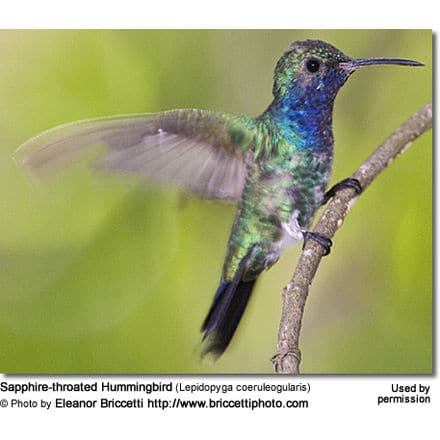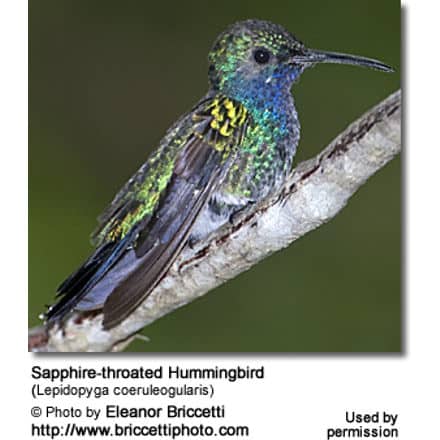Sapphire-throated Hummingbirds
The Sapphire-throated Hummingbird (Lepidopyga coeruleogularis) is a Central and South American hummingbird that occurs naturally from western Panama to northern Colombia, along most of the Pacific slope and over the eastern region of the Caribbean slope of Panama into Colombia. There are reports of it also being endemic to Costa Rica, however, this may be based on a possibly mislabeled specimen and from an unconfirmed record from 1962.
It is most commonly found in coastal forests (Ridgely and Gwynne 1989), where they occupy secondary forests and scrubby clearings and around mangrove patches.
Subspecies
- Lepidopyga coeruleogularis coeruleogularis (Gould, 1851) – Nominate Race
- Range: Pacific slope of western Panama from Chiriquí to Canal Zone
- Lepidopyga coeruleogularis confinis (Griscom, 1932)
- Range: Eastern Panama (Caribbean slope of Darién) and adjacent northwest Colombia
- Lepidopyga coeruleogularis coelina (Bourcier, 1856)
- Range: Northern Colombia, from north Chocó through Ciénaga Grande to Santa Marta
Nesting / Breeding
Hummingbirds are solitary in all aspects of life other than breeding, and the male’s only involvement in the reproductive process is the actual mating with the female. They neither live nor migrate in flocks, and there is no pair bond for this species. Males court females by flying in a U-shaped pattern in front of them. He will separate from the female immediately after copulation. One male may mate with several females. In all likelihood, the female will also mate with several males. The males do not participate in choosing the nest location, building the nest, or raising the chicks.
The female is responsible for building the cup-shaped nest out of plant fibers woven together and green moss on the outside for camouflage in a protected location in a shrub, bush or tree. She lines the nest with soft plant fibers, animal hair, and feathers down, and strengthens the structure with spider webbing and other sticky material, giving it an elastic quality to allow it to stretch to double its size as the chicks grow and need more room. The nest is typically found on a low, thin horizontal branch.
Hummingbird Resources
- Hummingbird Information
- Hummingbird Amazing Facts
- Attracting Hummingbirds to Your Garden
- Hummingbird Species
- Feeding Hummingbirds
The average clutch consists of two white eggs, which she incubates alone, while the male defends his territory and the flowers he feeds on. The young are born blind, immobile and without any down.
The female alone protects and feeds the chicks with regurgitated food (mostly partially digested insects since nectar is an insufficient source of protein for the growing chicks). The female pushes the food down the chicks’ throats with her long bill directly into their stomachs.
As is the case with other hummingbird species, the chicks are brooded only the first week or two and are left alone even on cooler nights after about 12 days – probably due to the small nest size. The chicks leave the nest when they are about 7 – 10 days old.
Diet / Feeding
The Sapphire-throated Hummingbirds primarily feed on nectar taken from a variety of brightly colored, scented small flowers of trees, herbs, shrubs, and epiphytes. They favor flowers with the highest sugar content (often red-colored and tubular-shaped) and seek out, and aggressively protect, those areas containing flowers with high-energy nectar. They use their long, extendible, straw-like tongues to retrieve the nectar while hovering with their tails cocked upward as they are licking at the nectar up to 13 times per second. Sometimes they may be seen hanging on the flower while feeding.
Hummingbird Information




